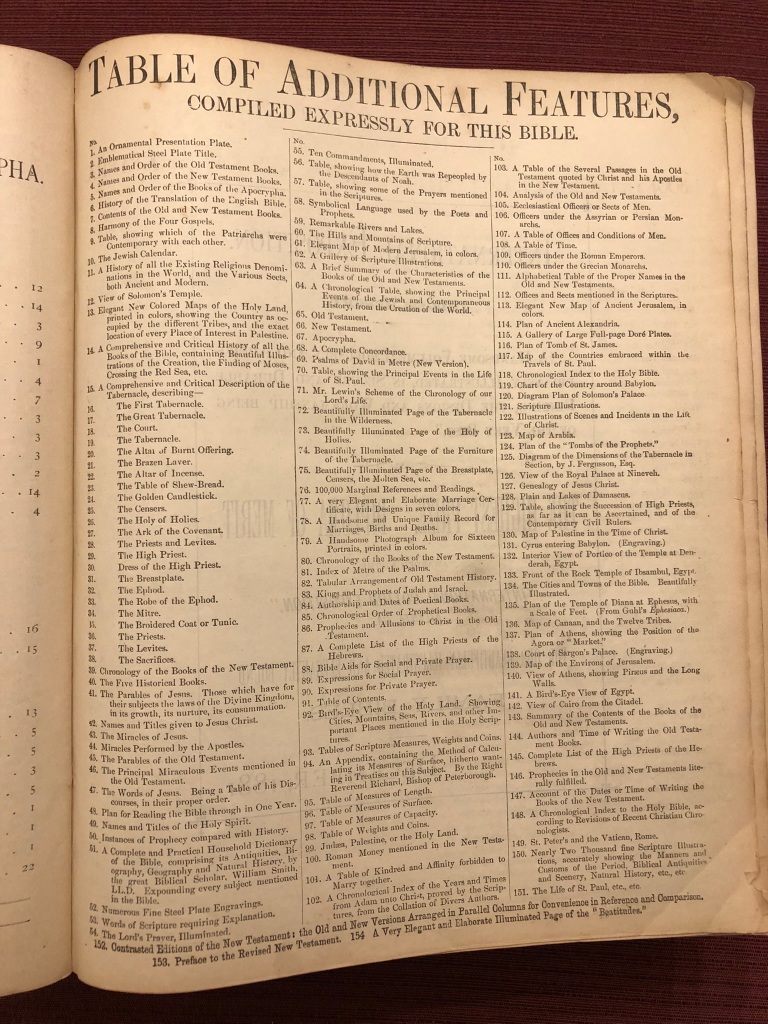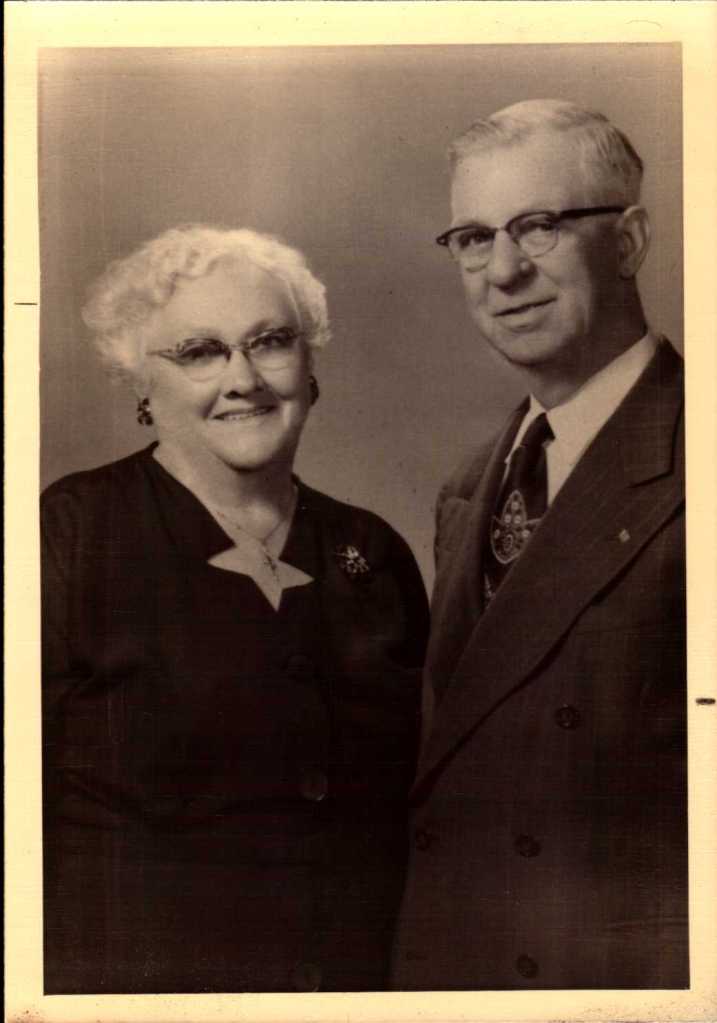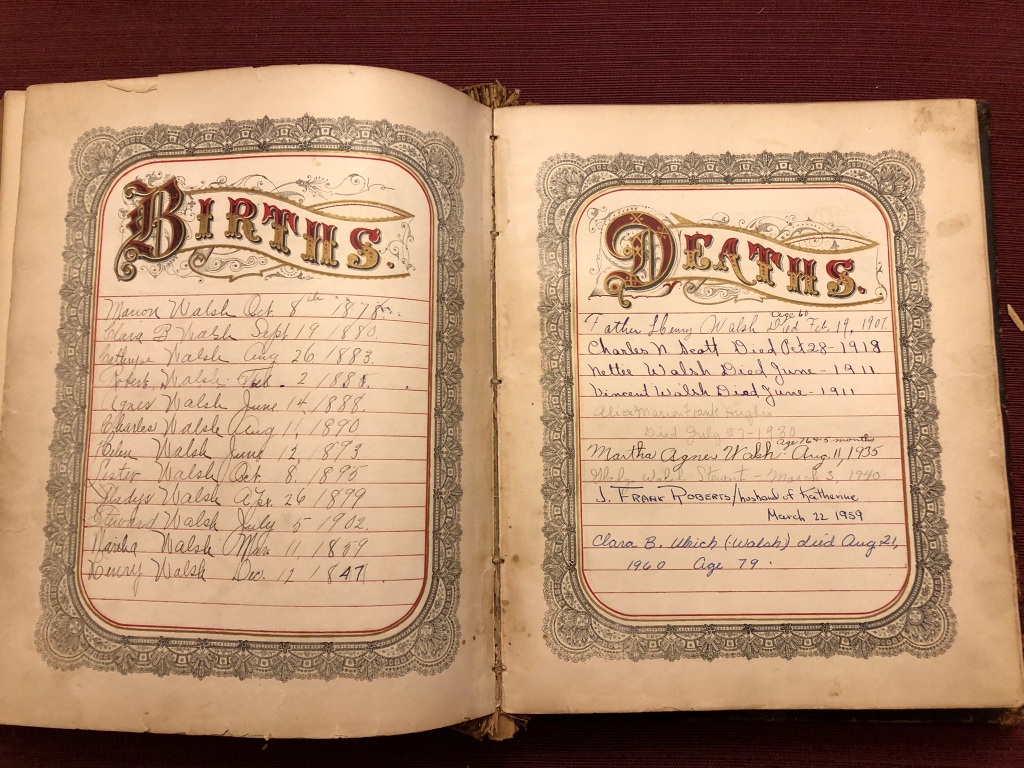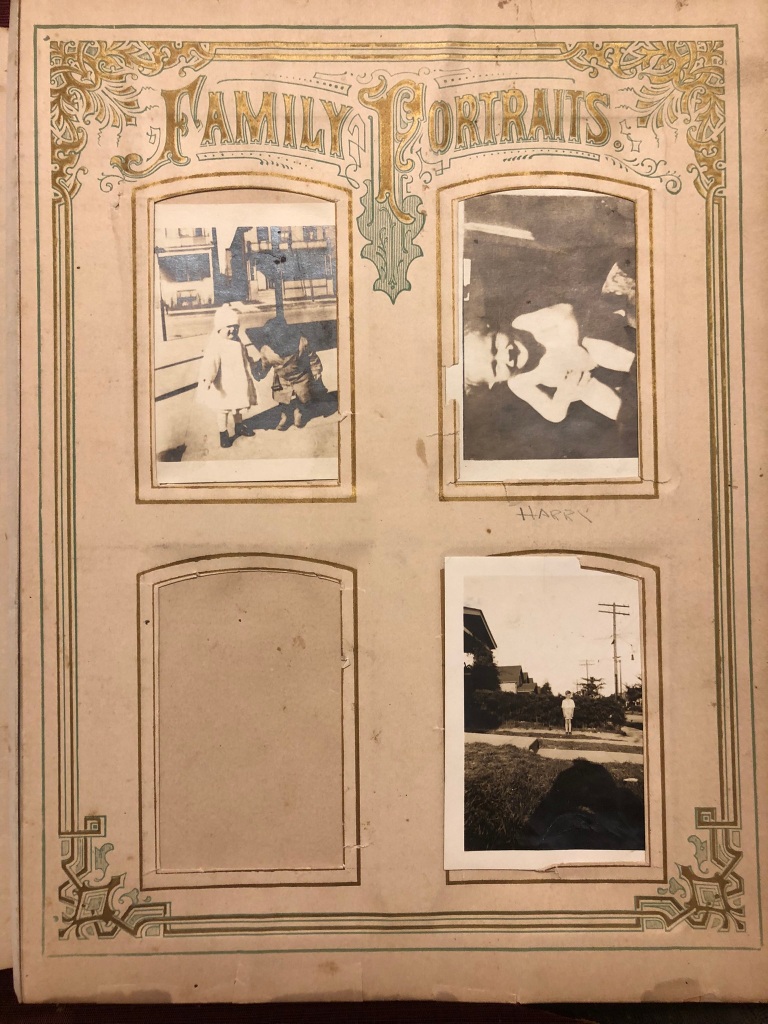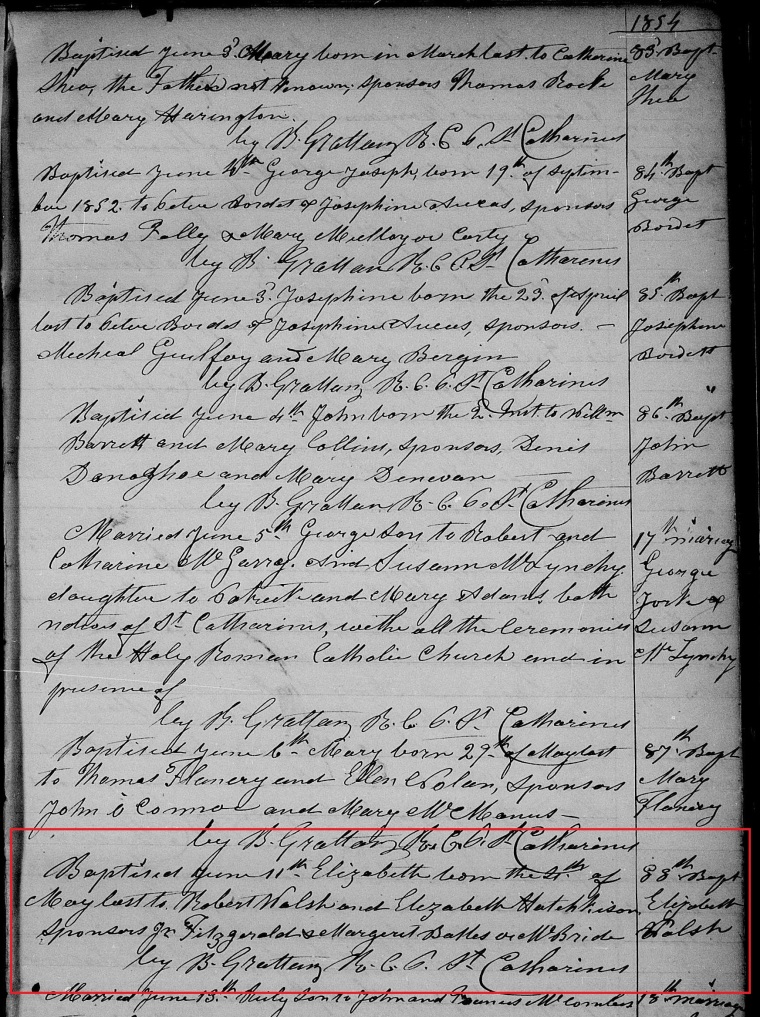Recently, I wrote about the challenges inherent to genealogists as they track name changes and variant surname spellings used by their immigrant ancestors. I used the example of the Batkiewicz/Bartkiewicz/Watkiewicz/Wątkiewicz family of Buffalo, New York, who informally changed their surname to Bitner/Bittner between 1910 and 1915. Although Polish surnames would seem to be especially susceptible to such changes, similar examples can be found across all ethnic groups, and even the “simple” Irish surname, Walsh, has been recorded with multiple variant spellings, ranging from Welch and Welsh to Breatnach, according to Irish researcher John Grenham.1
However, I’ve encountered another such example that’s so much fun, that I just have to share it. If you’re a regular reader of this blog, you may recall my ongoing quest to identify parents and place of birth for my great-great-grandmother, Antonina Zarzycka, whose maiden name was variously recorded as Naciążek, Raciążek, and Maciążek. Last fall, I was finally able to locate birth and death records for her which confirmed that her parents were Franciszek and Marianna (Kowalska) Naciązek. Of course, one discovery leads to another, and Franciszek Naciążek was identified as the son of Piotr and Małgorzata (__) Naciążek.2 Furthermore, there’s evidence that Piotr and Małgorzata had a daughter, Anna, who married Antoni Szyfrynowicz,3 and that’s where the variant-surname mayhem begins.
Introducing Antoni and Anna Szyfrynowicz/ Zytnerowicz/Szufrynowicz/Sypnorowicz… Whatever!
The picture that has emerged from the research thus far looks like this: Anna Naciążek was born to Piotr and Małgorzata (__) Naciążek between 1798 and 1804 in the village of Giżyce, in what is now Sochaczew County, Poland. She was born during that brief historical interlude when this area was under Prussian control, between the final partition of Poland in 1795 and the creation of the Duchy of Warsaw in 1807. (Further information on Poland’s changing borders can be found here.) She married Antoni Szyfrynowicz circa 1822, estimated from the 1823 birth of their oldest child discovered to date. However, the picture of these earliest years of Anna’s life is clouded by a lack of available evidence.
Significant gaps exist in collections of vital records for Giżyce from both the Archiwum Diecezji Łowickiej (diocesan archive in Łowicz) which has no birth records prior to 1826, and no marriage records prior to 1827, as well as the Archiwum Państwowe w Warszawie Oddział w Grodzisku Mazowieckim (state archive in Grodzisk Mazowiecki), which has limited birth, marriage and death records from the first half of the 19th century (1810, and 1823–1825 only). Furthermore, I believe that all the early 19th-century (and earlier) records from the parish archive have now been transferred to the diocesan archive, as discussed previously, so there’s no hope of finding additional records onsite at the parish to fill those gaps. This means that Anna’s birth record, her marriage record, and the birth records of any children born prior to 1823, may no longer exist, which complicates the research.
Nonetheless, we know that Antoni and Anna had a daughter, Katarzyna Marianna Zytnerowicz, who was born in Giżyce on 29 April 1823.4 Following Katarzyna’s birth in Giżyce, the family migrated to the village of Walewice in Bielawy parish, some 46 km/29 miles away, where their son, Ignacy Szufrynowicz, was born on 3 February 1825.5 Five years later, a daughter, Joanna Nepomucena Sypnorowicz, was born in the village of Śleszyn on 9 October 1830.6 Another daughter, Paulina Sitnerowicz, was born on 17 June 1833 in Budzyń,7 and the following year, Antoni and Anna suffered the loss of their daughter, Joanna, on 10 May 1834, while still living in Budzyń.8 At least within that parish, the same spelling of their surname was used consistently, and Joanna’s surname was recorded as Sitnerowicz on her death record, never mind the fact that she was Sypnorowicz when she was born.
By 1836, the family had migrated yet again, this time to Kiernozia, where their daughter, Marianna Szyfrynowicz, was born on 26 March 1836.9 Following a six-year gap, they emerged in the historical records in Leszno, 56 km/35 miles east of their previous residence in Kiernozia. Another daughter was born in Leszno—Marcella Agnieszka Szifnernowicz, on 16 January 1841.10 1843 found Antoni and Anna in Wiskitki, where a son, Wincenty Apolinary Szafranowicz was born on 8 January 1843.11 He died in Wiskitki two months later, on 12 March 1843 under the name Wincenty Appolinary Sznuffrynowicz.12
Antoni and Anna’s youngest known child was another daughter named Joanna who was born 24 May 1844 back in Śleszyn.13 She was baptized as Joanna Sitnerowicz, but was recorded as Joanna Szyfrynowicz when she died at the age of three on 3 March 1847 in Tomczyce.14 By 1848, the family had returned to Walewice, where their eight-year-old daughter, Józefa Szufrynowicz, died on 13 November 1848.15 Józefa’s birth record has not yet been located. Her age at the time of death suggests a birth circa 1840, but the fact that Anna and Antoni’s daughter Marcella was born in January 1841, suggests a greater likelihood that Józefa was born earlier, circa 1839.
At this point, it’s not known where the family was living at that time. Leszno would be a possibility, since that’s where Marcella was born. However, birth records for Leszno are indexed in Geneteka for the entire period from 1808–1916 with no gaps, yet Józefa’s birth record is not found. Moreover, there are no promising matches in any indexed parish within the present-day Mazowieckie or Łódzkie provinces, which most likely suggests that Józefa was baptized in a parish whose records have not yet been indexed for that time period. Alternatively, her birth record may no longer exist.
Eighteen-year-old Paulina Szyfnerowicz died on 1 February 1852 while employed as a housekeeper at Walewice Palace.16 Her sister, Marianna Szyfrynowicz, married Michał Trafalski on 17 June 1855 in Oporów,17 but died two years later in Wola Owsiana, on 24 October 1857.18 Their father, Antoni Szyfrynowicz, died on 9 February 1862 in the village of Osiny.19 A map showing the family’s travels between 1822 and 1862 is shown in Figure 1.
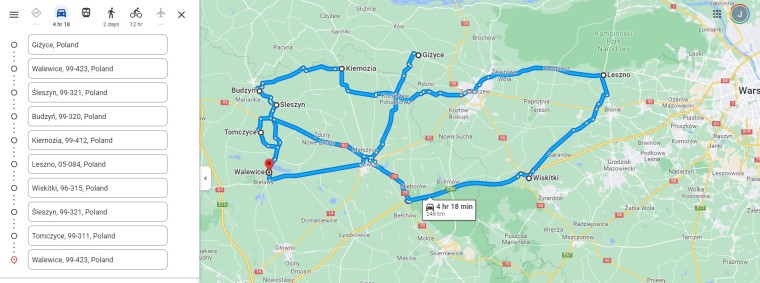
Anna herself died six years later, in the village of Wymyśłow, on 7 August 1868. Her death record, written in Russian, is shown in Figure 2.3

This is the only record discovered to date which identifies Anna’s parents as Piotr and Małgorzata, thus appending her to my family tree. In translation,* the record states,
“No. 18. Wymysłów.
It happened in the town of Głowno on the eighth day of August in the year one thousand eight hundred sixty-eight at four o’clock in the afternoon. Filip Jagiełło, age thirty-two, and Marcin Nadolski, age twenty-six, manorial farm servants, living in the village of Wymysłów, appeared and stated that yesterday, at two o’clock in the morning, Anna Szyfrynowicz, née Naciążek, died, a widow of her deceased husband, Antoni Szyfrynowicz, laborer living in the village of Wymysłów, born in the village of Giżyce, daughter of the deceased spouses Piotr and Małgorzata Naciążek; she leaves behind her daughter Marcella; the deceased was age seventy. After visual confirmation of the death of Anna Szyfrynowicz, this document was read to those present and was signed only by Us due to their illiteracy. [signed] Rev. Stanisław Biekalski, Keeper of the Civil Registers, Głowno Parish.”
The fact that only one daughter is mentioned in the death notice suggests that Anna outlived eight of her nine children, although death records have not yet been discovered for the oldest two children, Katarzyna and Ignacy. Marcella’s story continues through vital records, and additional documents pertaining to the parents and siblings of Antoni Szyfrynowicz could probably be located; however, the examples shown thus far pertaining to Antoni and Anna’s immediate family are sufficient to illustrate the challenges inherent to this research.
Researching the Szyfrynowicz Family in Geneteka
All of this evidence for the Szyfrynowicz family was discovered thanks to the Polish vital records database, Geneteka. The surname variants, and the number of occurrences of each, are summarized in the table shown in Figure 3.
| Surname Variant | Occurrences Found in Vital Records |
| Sitnerowicz | 3 |
| Sypnorowicz | 2 |
| Szafranowicz | 1 |
| Szifnerowicz | 1 |
| Sznuffrynowicz | 1 |
| Szufrynowicz | 2 |
| Szyfnerowicz | 1 |
| Szyfrynowicz | 5 |
| Zytnerowicz | 1 |
In addition to the wildly divergent surname variations observed with the Szyfrynowicz surname, Anna’s maiden name was found to be all over the place, as well. Although Naciażek was the spelling used in nine historical records,4, 8, 9, 10, 12,14,16,17,18 there were two instances of Maciążek,6,13 and one each of Maciorek,11 Naciąszek,7 and Zaciąska.5 Additionally, Anna’s maiden name was identified as Strzelecka in the death record of her daughter, Józefa.15 However, in light of the body of evidence, this can be considered a more egregious recording error, rather than a benign etymological or phonetic variant. In records pertaining to my great-great-grandmother, Antonina (Naciążek) Zarzycka, the surname variant Raciążek was also used on eight of the 22 documents which identified her maiden name. Nonetheless, Naciążek was the predominant variant found for her, as well.
Polish surname variants tend to arise based on common etymology, and similar phonetics. The surname Grzesiak, for example, derives from the given name Grzegorz (Gregory),20 so variant spellings found in historical records for the same individual or family might include Grzesiek, Grzeszak, Grzeszczak, Greześkiewicz, etc. Similarly, members of the Bartoszewicz family might be recorded as Bartosiewicz, Bartusiewicz, and Bartoszewski. A simple wildcard search in Geneteka is usually an effective strategy for dealing with these issues. A search for “Bart*” will include all etymological and phonetic surname variants that begin with these four letters. However, research into the Szyfrynowicz family is complicated by the lack of common etymological or phonetic patterns found in the first few letters of the surname, as shown in Figure 3. The only pattern found within all examples of the surname is the “-owicz” ending. Unfortunately, Geneteka does not permit the wildcard character (*) to be used as the first letter of a surname in such a way that it helps to resolve this problem. To clarify, it’s possible to perform a search for the surname, “*owicz,” but results do not include all indexed Polish surnames ending in “-owicz.” Instead, the asterisk is ignored, and results include surnames that begin with “Owicz-” as well as surnames that were undecipherable to the indexer and contain a question mark (?) or an ellipsis (…).
For this reason, searches for records pertaining to Antoni and Anna’s family were accomplished more easily by using Anna’s maiden name as a search term, rather than her married surname. The wildcard strategy was somewhat more effective that way, since a search for “Naci*” will include results for Naciążek, Naciak, and Naciąszek. However, the search must be repeated for “Raci*” and “Maci*” in order to tease out all possible variants related to those spellings. In contrast, wildcard searches for Anna’s married surname employing “S*” or “Z*” are too broad, yet the inclusion of even a second character in the search string makes them already too narrow, based on the list of surnames shown in Figure 3. Research into the Szyfrynowicz family was further complicated by the family’s migrations, which spanned villages located in both the present day Łódzkie and Mazowieckie provinces. This fact necessitated the repetition of all searches in both provinces, since searches in Geneteka are limited to one province at a time. All of these factors illustrate the importance of thinking broadly when devising strategies for searches in Geneteka.
This research into the Szyfrynowicz family illustrates the slipperiness of the “original surname” concept. Many researchers are under the impression that surname changes and variant spellings are a problem unique to immigrants to the U.S. or Canada. If they are able to trace their family back to records from the Old Country, they reason, it will be possible to identify the one, true version of the surname. Unfortunately, the reality is rarely so simple. In the case of the Szyfrynowicz family, the preferred version of the surname was found on only five of 17 vital records pertaining to the family. Sometimes, the best you can do is to keep gathering data, until a preponderance of evidence is obtained.
Sources:
1 John Grenham, “All variants of Walsh,” Irish Ancestors (https://www.johngrenham.com/ : accessed 28 March 2023).
2 Roman Catholic Church (Sochaczew, Sochaczew, Mazowieckie, Poland), “Akta stanu cywilnego Parafii Rzymskokatolickiej w Sochaczewie, 1781-1901,” Księga małżeństw, 1826-1842, 1826, no. 7, Franciszek Naciążek and Marianna Kowalska; Archiwum Diecezjalne w Łowiczu, ul. Stary Rynek 19 A, 99-400, Łowicz, Polska/Poland; and
Roman Catholic Church, Kocierzew Południowy parish (Kocierzew Południowy, Łowicz, Łódź, Poland), “Akta stanu cywilnego Parafii Rzymskokatolickiej w Kocierzewie, 1812 – 1918,” Księga urodzeń, małżeństw i zgonów, 1844 r. [Book of births, marriages and deaths, 1844], Małżeństw [Marriages], no. 34, Franciszek Naciążek and Marianna Siekiera, née Kotlarska; digital image, Skanoteka – Metryki: Baza skanów akt metrykalnych (https://metryki.genealodzy.pl : 28 March 2023), Zespół: 1514d, Jednostka: 1844 / UMZ-1844, Katalog: Małżeństwa, Plik: 034-035.jpg.
3 Roman Catholic Church, Głowno parish (Głowno, Zgierz, Lódz, Poland), “Akta stanu cywilnego Parafii Rzymskokatolickiej w Głownie, 1808 – 1919,” 1868, Deaths, no. 18, Anna Szyfrzynowicz; digital image, Skanoteka – Metryki: Baza skanów akt metrykalnych (https://metryki.genealodzy.pl/: accessed 28 March 2023), Zespół: 1474d, Jednostka: 1868 / UMZ-1868, Katalog: Zgony, Plik 15-18.jpg.
4 Roman Catholic Church, Giżyce parish (Giżyce, Iłów, Mazowieckie, Poland), “Akta stanu cywilnego parafii rzymskokatolickiej w Giżycach, 1810–1928 r.”, Akta Narodzonych w Roku 1823 [Birth Certificates, 1823], no. 8, Katarzyna Maryanna Zytnerowicz; digital image, Metryki GenBaza (https://metryki.genbaza.pl/ : accessed 28 March 2023), citing Archiwum Państwowe w Warszawie Oddział w Grodzisku Mazowieckim, Sygnatura [Reference code] 73/66/0.
5 Roman Catholic Church, Bielawy parish (Bielawy, Łowicz, Łódź, Poland), “Akta stanu cywilnego Parafii Rzymskokatolickiej w Bielawach, 1809 – 1877 r.”, Akta urodzeń, małżeństw i zgonów, 1825 r. [Birth, marriage and death files, 1825], Urodzenia [births], no. 10, Ignacy Szufrynowicz; digital image, Skanoteka – Metryki: Baza skanów akt metrykalnych.
(https://metryki.genealodzy.pl : 28 March 2023), Zespół: 1409d, Jednostka: 1825 / UMZ-1825, Katalog: Urodzenia, Plik: 08-11.jpg; citing Archiwum Państwowe w Łodzi.
6 Roman Catholic Church (Śleszyn, Kutno, Łódź, Poland), “Akta stanu cywilnego Parafii Rzymskokatolickiej w Sołek–Śleszynie, 1810-1875,” Akta urodzeń, małżeństw i zgonów [Birth, marriage and death certificates], 1830; Urodzenia [births], no. 36, Joanna Sypnorowicz; indexed by anton_burza, Geneteka (https://geneteka.genealodzy.pl/ : accessed 28 March 2023); image copy obtained from indexer, citing Archiwum Państwowe w Łodzi, Sygnatura 39/1675/0.
7 Roman Catholic Church, Żychlin parish (Żychlin, Kutno, Łódź, Poland), “Akta stanu cywilnego Parafii Rzymskokatolickiej w Żychlinie, 1808–1911,” [Civil Status Records of the Roman Catholic Parish in Żychlin, 1808 – 1911], Akta urodzeń, małżeństw i zgonów, 1833 r. [Birth, marriage, and death certificates, 1833], Urodzenia [Births], no. 52, Paulina Sitnerowicz; digital image, Skanoteka – Metryki: Baza skanów akt metrykalnych (https://metryki.genealodzy.pl : 28 March 2023), Zespół: 1757d, Jednostka: 1833 / UMZ-1833, Katalog: Urodzenia, Plik: 052-059; citing Archiwum Państwowe w Łodzi.
8 Ibid., Akta urodzeń, małżeństw i zgonów, 1834 r. [Birth, marriage and death certificates, 1834] Zgony [deaths], no. 31, Joanna Sitnerowicz; digital image, Skanoteka – Metryki: Baza skanów akt metrykalnych (https://metryki.genealodzy.pl : 28 March 2023), Zespół: 1757d, Jednostka: 1834 / UMZ-1834, Katalog: Zgony, Plik: 29–36; citing Archiwum Państwowe w Łodzi.
9 Roman Catholic Church, Kiernozia parish (Kiernozia, Łowicz, Łódź, Poland), “Akta stanu cywilnego Parafii Rzymskokatolickiej w Kiernozi, 1810-1888 r,” Akta urodzeń, małżeństw i zgonów, 1836 r. [Birth, marriage and death certificates, 1836], Urodzenia [births], no. 14, Marianna Szyfrynowicz; digital image, Skanoteka – Metryki: Baza skanów akt metrykalnych (https://metryki.genealodzy.pl/ : accessed 28 March 2023), Zespół: 1508d, Jednostka: 1836 / UMZ-1836, Katalog: Urodzenia, Plik: 10-15; citing Archiwum Państwowe w Łodzi.
10 Roman Catholic Church, Leszno parish (Leszno, Warszawa Zachodnia, Mazowieckie, Poland), “Akta stanu cywilnego parafii rzymskokatolickiej w Lesznie,1826 – 1913,” Ksiega Duplikat do zapisywania Akt Religijno-Cywilnych Urodzenia Malzenstw i Zeyscia dla Parafii Leszno na Rok 1841 r. [Duplicate Book of Religious Civil Certificates of Birth, Marriage, and Death of the Parish of Leszno, 1841], Urodzenia [Births], no. 9, Marcella Agnieszka Szifnerowicz; digital image, Skanoteka – Metryki: Baza skanów akt metrykalnych (https://metryki.genealodzy.pl/ : accessed 28 March 2023), Zespól: 0071d. Jednostka: 116, Katalog: Urodzenia, Plik: 004-009.jpg; citing Archiwum Państwowe w Warszawie Oddział w Grodzisku Mazowieckim.
11 Roman Catholic Church, Wiskitki parish (Wiskitki, Zyrardów, Mazowieckie, Poland), “Akta stanu cywilnego parafii rzymskokatolickiej w Wiskitkach, 1826 – 1911,” Akta urodzeń, małżeństw i zgonów, 1843 r. [Birth, marriage and death certificates, 1843], Urodzenia [births], no. 15, Wincenty Apolinary Szafranowicz; digital image, Skanoteka – Metryki: Baza skanów akt metrykalnych (https://metryki.genealodzy.pl : 28 March 2023), Zespół: 0061d, Jednostka: 1843 / Księga UMZ-1843 r., Katalog: Urodzenia, Plik: 010-015; citing Archiwum Państwowe m. st. Warszawy, Oddział w Grodzisku Mazowieckim.
12 Ibid., Księga urodzeń, małżeństw i zgonów, 1843 r. [Book of births, marriages, and deaths, 1843], zgony [deaths], no. 56, Wincenty Appolinary Sznuffrynowicz; digital image, Skanoteka – Metryki: Baza skanów Akt Metrykalnych (https://metryki.genealodzy.pl/ : accessed 28 March 2023, Zespól: 0061d, Jednostka: 1843 / Ksiega UMZ-1843 r., Katalog: Zgony, Plik: 053-060.jpg; citing Archiwum Państwowe m. st. Warszawy, Oddział w Grodzisku Mazowieckim.
13 Roman Catholic Church (Śleszyn, Kutno, Łódź, Poland), “Akta stanu cywilnego Parafii Rzymskokatolickiej w Sołek – Śleszynie, 1810 – 1875,” Akta urodzeń, małżeństw i zgonów [Birth, marriage and death certificates], 1844; Urodzenia [births], no. 28, Joanna Sitnerowicz; indexed by anton_burza, Geneteka (https://geneteka.genealodzy.pl/ : 24 March 2023); image copy obtained from indexer, citing Archiwum Państwowe w Łodzi.
14 Roman Catholic Church, Plecka Dąbrowa parish (Plecka Dąbrowa, Kutno, Łódź, Poland), “Akta stanu cywilnego Parafii Rzymskokatolickiej w Pleckiej Dąbrowie, 1810-1918,” Księga urodzeń, małżeństw i zgonów [Book of births, marriages, and deaths], 1847, zgony [deaths], no. 4, Joanna Szyfrynowicz; digital image, Skanoteka – Metryki: Baza skanów akt metrykalnych (https://metryki.genealodzy.pl : accessed 28 March 2023), Zespół: 1627d, citing Archiwum Państwowe w Łodzi.
15 Roman Catholic Church, Bielawy parish (Bielawy, Łowicz, Łódź, Poland), “Akta stanu cywilnego Parafii Rzymskokatolickiej w Bielawach, 1809 – 1877 r.,” Akta urodzeń, małżeństw i zgonów, 1848 r. [Birth, marriage and death files, 1848], zgony [deaths], no. 140, Józefa Szufrynowicz; digital image, Skanoteka – Metryki: Baza skanów akt metrykalnych (https://metryki.genealodzy.pl : 28 March 2023); Zespół: 1409d, Jednostka: 1848 / UMZ-1848, Katalog: Urodzenia, Plik: 127-140; citing Archiwum Państwowe w Łodzi.
16 Roman Catholic Church, Bielawy parish (Bielawy, Łowicz, Łódź, Poland), “Akta stanu cywilnego Parafii Rzymskokatolickiej w Bielawach, 1809 – 1877 r.,” [Civil Status Files of the Roman Catholic Parish of Bielawy, 1809 – 1877], Akta urodzeń, małżeństw i zgonów, 1852 r. [Birth, marriage and death files, 1852], zgony [deaths], no. 9, Paulina Szyfnerowicz; digital image, Skanoteka – Metryki: Baza skanów akt metrykalnych (https://metryki.genealodzy.pl/ : 28 March 2023), Zespół: 1409d, Jednostka: 1852 / UMZ-1852, Katalog: zgony, Plik: 009-014; citing Archiwum Państwowe w Łodzi.
17 Roman Catholic Church, Oparów parish (Oparów, Kutno, Łódź, Poland), “Akta stanu cywilnego Parafii Rzymskokatolickiej w Oporowie, 1808 – 1919,” Akta urodzeń, małżeństw i zgonów [Birth, marriage and death certificates], 1855, Małżeństwa [marriages], no. 14, Michal Trafalski and Maryanna Szyfrynowicz; digital image, Skanoteka – Metryki: Baza skanów akt metrykalnych (https://metryki.genealodzy.pl/ : accessed 28 March 2023), Zespół: 1606d, Jednostka: 1855 / UMZ-1855, Katalog: Małżeństwa, Plik: 12-15; citing Archiwum Państwowe w Łodzi.
18 Ibid., Akta urodzeń, małżeństw i zgonów, 1857 r. [Birth, marriage and death certificates, 1857], zgony [deaths], no.68, Maryanna Trafalska; digital image, Skanoteka – Metryki: Baza skanów akt metrykalnych (https://metryki.genealodzy.pl/ : accessed 28 March 2023), Zespół: 1606d, Jednostka: 1857 / UMZ-1857, Katalog: Zgony, Plk: 61-68; citing Archiwum Państwowe w Łodzi.
19 Roman Catholic Church, Dmosin parish (Dmosin, Brzeziny, Łódź, Poland), “Akta stanu cywilnego Parafii Rzymskokatolickiej w Dmosinie, 1808 – 1920,” Akta urodzeń, małżeństw i zgonów, 1862 r. [Birth, marriage and death certificates,1862), Zgony [deaths], no. 14, Antoni Szyfrzynowicz; digital image, Skanoteka – Metryki: Baza skanów akt metrykalnych (https://metryki.genealodzy.pl/ : accessed 28 March 2023), Zespół: 1456d, Jednostka: 1862 / UMZ-1862, Katalog: Zgony, Plik: 010-015; citing Archiwum Państwowe w Łodzi.
20 William F. Hoffman, Polish Surnames: Origins and Meanings, 3rd Edition, Vol. 2 (Chicago, Illinois: Polish Genealogical Society of America, 2012), p 224, “entry for “Grzes-.”
*I would like to acknowledge with gratitude the kind assistance of Monika Deimann-Clemens in reviewing my translation of Anna Szyfrynowicz’s death record.
© Julie Roberts Szczepankiewicz, 2023











